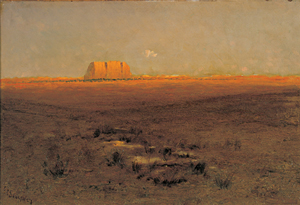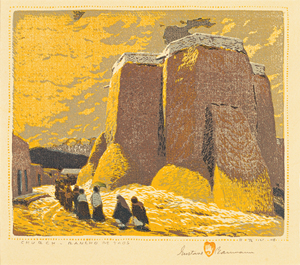Agriculture
Overview
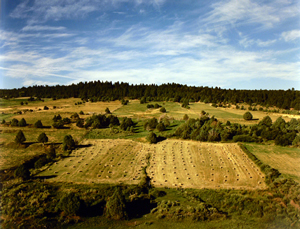 The total value of the agriculture output from New Mexico farmers and ranchers was $3.3 billion in 2007. New Mexico produces more chile than any other state in the country, and we rank second in pecan production. Within the state, milk is our number one cash commodity, followed by cattle and calves with a cash income of $955 million.
The total value of the agriculture output from New Mexico farmers and ranchers was $3.3 billion in 2007. New Mexico produces more chile than any other state in the country, and we rank second in pecan production. Within the state, milk is our number one cash commodity, followed by cattle and calves with a cash income of $955 million.
What makes farming in New Mexico unique?
Soil
- Penistaja soils are the state soil of New Mexico and cover more than 1 million acres.
- They are very productive grass and forage soils and are excellent for livestock grazing, wildlife habitat, and recreation.
Climate
The New Mexico climate is typical of high desert conditions. There is a large amount of sun, wide temperature ranges, and lots of wind.
- The days are warm and the nights cool.
- The mean annual precipitation is about 12 inches.
- The mean annual soil temperature is about 51 degrees F.
General
- Annual crop and livestock sales exceeded $3.3 billion in 2007.
- Agriculture directly employs 24,500 workers in New Mexico. Another 84,000 workers are employed in agricultural processing.
- The average size of a New Mexico farm is 3,249 acres.
- Farmland covers 45,787,108 acres, or 60% of the state; 89% of that farmland is pasture ground.
Crops
- Over 350,000 acres are in hay production with a total yield of 1.55 million tons.
- Over 49,000 dry tons of chile pepper was grown in New Mexico in 2007 with an estimated worth of $28.68 million.
- Over 35 million pounds of peanuts were produced in 2007.
- The 2007 cotton crop was valued at over $38 million with over 98,000 bales produced.
- Over 6,300 acres were in onion production in 2007 with a total harvest value of $63.4 million.
Acknowledgment
New Mexico State University
Las Cruces, New Mexico
“The Three Sisters:” Production of Beans, Corn and Squash in New Mexico
The “three sisters” of New Mexican agriculture, corn, beans, and squash, were hundreds of years ahead of their time. This system serves as the basis for inter-cropping systems currently being used around the world as tools to increase agricultural productivity in areas facing food shortages.
Each of the “three sisters” serves an important role and supports and benefits the others. To understand the system, one should first consider the three plants separately. Growing corn in rows is a good idea but wastes valuable planting space. Beans require some sort of support system and must be staked up to grow. Finally, both squash and corn require additional nitrogen in the soil to produce adequately in New Mexico’s typically sandy soils, which are also prone to losing valuable moisture due to evaporation.
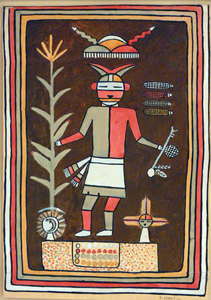 As corn reaches for the sun, beans may grow up the strong stalks and the necessity of building a support system or frame is reduced. One must plant corn some distance apart, leaving the ground bare; however, planting squash between the rows of corn reduces soil moisture loss as the squash foliage acts as a natural mulch, reducing soil temperatures and helping to “hold” moisture in the soil where it may be used by the plants and not get lost in the atmosphere. Finally, beans have the unique capability of being able to “fix” atmospheric nitrogen, pulling it from the air and improving soil nitrogen status, essentially, “fertilizing” the other two sisters…and keeping the soil fertile by converting the sun’s energy into nitrogen-filled nodules that grow on its roots.
As corn reaches for the sun, beans may grow up the strong stalks and the necessity of building a support system or frame is reduced. One must plant corn some distance apart, leaving the ground bare; however, planting squash between the rows of corn reduces soil moisture loss as the squash foliage acts as a natural mulch, reducing soil temperatures and helping to “hold” moisture in the soil where it may be used by the plants and not get lost in the atmosphere. Finally, beans have the unique capability of being able to “fix” atmospheric nitrogen, pulling it from the air and improving soil nitrogen status, essentially, “fertilizing” the other two sisters…and keeping the soil fertile by converting the sun’s energy into nitrogen-filled nodules that grow on its roots.
In the Southwest, a fourth “sister” is found: the Rocky Mountain bee plant. Often growing near former Ancestral Pueblo settlements (it is virtually an indicator plant for ancient ruins) this two-to-five-foot tall, pink flowered cleome is a powerful attractant for beneficial insects that pollinate beans and squash. The young leaves, flowers, and seed pods of bee plant are edible, and native people boiled and ate them, or made a paste from the plant for later use. Bee plant also accumulates iron, and thus is the source of a deep-hued paint used to create the characteristic black designs on Ancestral pueblo pottery. Songs and blessings of New Mexico’s Tewa people mention corn, beans, squash, and bee plant, indicating that this multi-functional flower is an integral member of a sacred plant pantheon.
Acknowledgment
The Three Sisters
Dr. Dann Brown, Professor of Botany
Eastern New Mexico University
Copyright 2005 NMSU Board of Regents
http://horizon.nmsu.edu/kids/webquests/3sisresources.html
Chile Production in New Mexico
Chile has become symbolic of New Mexico culture and is one of the state’s biggest crops. Chiles have long been used in folk medicine, for their flavor and heat, and lately they’ve been found to have strong antibacterial qualities. They are loaded with nutrients including calcium, iron and vitamins A and C, and are sometimes used to relieve headaches. Bright red chile ristras decorate our homes.
Chile, which originated near Bolivia, is New Mexico’s most valuable vegetable—although it’s technically a fruit. It belongs to the same family as tomatoes and eggplants. As a niche cash crop, the state’s chile is worth about $60 million at harvest. After processing, its value quadruples to more than $240 million. About 95% of the crop is harvested from seven southern and eastern New Mexico counties.
Spanish settlers brought chile into what is now New Mexico in the 1600’s. Over the centuries, plant breeders transformed the plants from an unpredictable mix of shapes, sizes and heat levels to today’s uniform pods. For more than a century, New Mexico State’s College of Agriculture and Home Economics has been aiding the state’s farmers in developing new and improved varieties, in addition to promoting innovative and economical new ways to harvest the stands.
In 1888, horticulturist Fabian Garcia, working at what was then known as the New Mexico College of Agriculture and Mechanical Arts, began a series of groundbreaking experiments to develop more standardized chile varieties. Early in the 1900s he released “New Mexico 9,” the first variety with a dependable pod size and heat level. New Mexico’s chile industry now boasts many varieties – greens, reds, jalapenos, cayennes and paprikas.
New Mexico State University researchers have recently introduced a new variety of chile, “NuMex Nematador,” a cayenne that is resistant to a devastating pest called the root-knot nematode. The pervasive parasitic worms thrive in New Mexico’s productive Mesilla Valley and attack chile plants’ roots. Nematador is expected to boost profits by reducing the expensive fumigation.
New Mexico state chile breeders developed a new paprika variety call “NuMex Garnet” that produces the reddest pigments commercially available. Throughout the world, red coloring is commonly extracted from paprika powder and used in a stunning range of consumer products from lipstick to pepperoni. Use of chile as a natural coloring agent began almost two decades ago, when the federal government banned a widely used red dye because of cancer risks….
Other New Mexico State researchers are looking at chile processing. For instance, the New Mexico Chile Pepper Task Force has identified mechanical harvesting of chile as key to the survival of the industry in the state. Hand harvesting of chile accounts for 40 to 60 percent of the total farm costs of chile pepper production for New Mexico. New Mexico growers pay a minimum of $5.15 per hour, while foreign competitors pay as little as $1 a day.
The U.S. Department of Energy’s Sandia National Laboratories, which often does research on advanced weapon design, agreed to aim its engineering horsepower at improving mechanical chile cleaning equipment. Under a new agreement, the New Mexico Chile Pepper Task Force and Sandia will focus on a troublesome problem for farmers as chile is harvested: too much of the plant is picked along with the peppers. Formed in 1998, the Las Cruces-based organization works to ensure that New Mexico’s chile industry is cost-effective enough to be competitive in a global marketplace. The focus is on best management practices, and developing effective drip irrigation practices and mechanical harvesting capabilities.
Acknowledgments
Nut Production in New Mexico
New Mexico is the fourth largest producer of nuts in the United States, according to Lois Ellen Frank, who is completing a PhD in culinary anthropology at the University of New Mexico, and is also an adjunct professor at the Institute of American Indian Arts (IAIA). In her New Mexico Magazine article, “Go Nuts!” she continues:
“The pinon is one of the oldest wild-harvested nuts in New Mexico, and the pinon pine is our state tree. The two-needle pinon is native to the United States and dates back at least 7,500 years….For millennia, its nuts were used by New Mexico’s Ancestral Puebloans and other historic tribes living in this region, and cracked nutshells are found at virtually all such archaeological sites. Pinon nuts contain the 20 amino acids that make up a complete protein, as well as more than 3,000 calories per pound, making the nut’s protein density comparable to that of steak. Of the nine amino acids essential to human growth, seven are concentrated in the pinon, which is also an excellent source of potassium. Whether eaten roasted or raw, pinon nuts are delicious by anyone’s standard.
"Another nut produced in New Mexico is the pecan. The pecan is the most common name for a species of hickory that belongs to the walnut family. Frank states, “Pecans grew wild in Texas and in northern Mexico….It is believed that they were then propagated to the north and east by wild crows, which prefer the thin-shelled nuts and can carry them many miles….The word pecan derives from the Algonquin word pacane, meaning ‘nut to be cracked with a rock.’ Wild pecans were a major source of food for various tribes, and some tribes’ activities and settlements actually followed the maturing harvest of the wild trees….Pecans are a good source of oleic acid, a monounsaturated fatty acid considered to be good for the heart. They contain more than 19 vitamins and minerals, and are a good source of vitamin E and fiber. Today, pecans are grown commercially in and around communities in southern New Mexico, including Alamogordo, Carlsbad, La Mesa, Las Cruces, Mesilla, and Roswell.”
"The Pistacia vera, or pistachio, a native of the Middle East, is grown in Alamogordo, which, Frank explains, “boasts one of the few climates in the United States with summers long, hot, and dry enough to grow pistachios.
"The eastern community of Portales is the top producer of organic peanuts. Valencia peanuts are the primary variety grown. Smaller and sweeter than their conventional counterparts, Valencias are favored by candy makers, and also make a satisfying peanut butter."
Acknowledgment
"Go Nuts!"
Story & Photography by Ellen Frank
New Mexico Magazine, October 2009
Ranching
In 1598, Juan de Onate left Mexico to settle New Mexico with 846 goats, 198 oxen, 2,517 sheep, 316 horses, 41 mules, 53 hogs, 500 calves, and 799 cows, steers and bulls. In the intervening 400 years, ranching has grown to become one of the largest industries in the state.
Mining
Minerals are the state’s richest natural resource, and New Mexico is one of the U.S. leaders in output of uranium and potassium salts. Petroleum, natural gas, coal, copper, gold, silver, zinc, lead, and molybdenum also contribute heavily to the state’s income.
Coal production
Coal production has played a significant role in the economic development of New Mexico beginning in the 1850’s and continuing to the present. It is one of the four mineral fuels produced in New Mexico, ranking third in value behind natural gas, (including coalbed methane) and crude oil. Coal resources underlie 12% (14.6 million acres) of the state’s total area. Most of the coal is in northern New Mexico, primarily in the San Juan and Raton basins. Several minor coal fields outside these basins have had significant production in the past, and some may become important in the future, in particular for coalbed methane production. Today, 46% of the state’s total energy needs are met through power generated from coal.
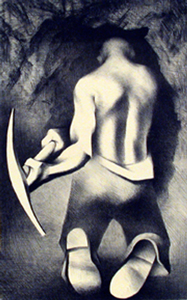 Coal is an important contribution to New Mexico’s state budget; it is the third largest source of revenues from mineral and energy production. Tax revenues (severance, resources excise, and conservation taxes, and royalties) from coal on state land were $30.7 million in 2001. New Mexico also receives 50% of the royalties collected on federal lands totaling $12.3 million in 2001. The coal industry directly employed 1,800 people in 2001 adding to the general economy of the State. Presently there are five operating coal mines in New Mexico, four surface and one underground operation. These mines produced 30.53 million tons in 2001, making New Mexico 12th in the nation for coal production.
Coal is an important contribution to New Mexico’s state budget; it is the third largest source of revenues from mineral and energy production. Tax revenues (severance, resources excise, and conservation taxes, and royalties) from coal on state land were $30.7 million in 2001. New Mexico also receives 50% of the royalties collected on federal lands totaling $12.3 million in 2001. The coal industry directly employed 1,800 people in 2001 adding to the general economy of the State. Presently there are five operating coal mines in New Mexico, four surface and one underground operation. These mines produced 30.53 million tons in 2001, making New Mexico 12th in the nation for coal production.
Acknowledgment
New Mexico Institute of Mining and Technology (NM Tech)
Oil and Gas Production
Although traces of oil and natural gas in New Mexico date back to the late 1800’s, the first successful gas well wasn’t completed until 1921, nine years after New Mexico gained its statehood. A year later, New Mexico’s first regular quantities of crude oil were produced in a well west of Farmington, New Mexico.
These firsts led to years of eager exploration for what became known as “black gold.” In 1924, Van S. Welch, Tom Flynn, and Martin Yates drilled the first commercial oil well in southeastern New Mexico. The State Land Office received its first royalty payment of $125 for oil produced on state land. This occasion marked the beginning of a fruitful industry for New Mexico, forever shaping our state’s future.
In November 1927, a successful well was established in Lea County, the location of New Mexico’s greatest oil and gas production. Two years later, the discovery of the world-famous Hobbs pool quickly earned New Mexico a place among the top ten oil producing states in the nation.
In the wake of the stock market crash of 1929, New Mexico oil and gas producers gathered on December 11th, to discuss industry issues and concerns. This marked the formation of the “New Mexico Oil Men’s Protective Association,” now known as the New Mexico Oil and Gas Association commonly referred to as NMOGA.
 Despite the nation’s financial turmoil, New Mexico’s oil industry quickly grew and by 1932 major pipelines extended into Lea County, transporting oil to eastern markets. In the same year, New Mexico established six refineries manufacturing gasoline, kerosene, heating oil, and road oil—a key factor to the development of New Mexico’s first asphalt highways. The market value of oil and gas tripled between 1932 and 1942 and New Mexico’s oil and gas industry flourished. At this time, the New Mexico Oil Conservation Commission was established, pioneering the controlled production of oil and gas so as to prevent unnecessary waste. New Mexico’s stance helped the United States Congress form the Interstate Oil and Gas Compact Commission, a government entity designed to regulate the nation’s petroleum production.
Despite the nation’s financial turmoil, New Mexico’s oil industry quickly grew and by 1932 major pipelines extended into Lea County, transporting oil to eastern markets. In the same year, New Mexico established six refineries manufacturing gasoline, kerosene, heating oil, and road oil—a key factor to the development of New Mexico’s first asphalt highways. The market value of oil and gas tripled between 1932 and 1942 and New Mexico’s oil and gas industry flourished. At this time, the New Mexico Oil Conservation Commission was established, pioneering the controlled production of oil and gas so as to prevent unnecessary waste. New Mexico’s stance helped the United States Congress form the Interstate Oil and Gas Compact Commission, a government entity designed to regulate the nation’s petroleum production.
Between 1952 and 1962, additional pipelines were built stretching from the gas fields of northwestern New Mexico to west coast markets. With distribution channels coast-to-coast, New Mexico’s oil and gas industry thrived. Advances in technology further contributed to the industry’s growth as recovery methods such as steam injection and solvent displacement became widely used. In 1960 Venezuela, Saudi Arabia, Iran and Kuwait formed OPEC, the Organization of Petroleum Exporting Countries, forever changing the face of the world’s petroleum industry.
The industry has, and continues to experience its share of booms and busts, economic highs and lows, and periods of growth and stagnation. Rolling with the punches, New Mexico has fared well. The state remains a top producer of oil and natural gas and in year 2000 produced approximately 10% of the nation’s gas supply and 65.4 million barrels of crude oil. New Mexico is the second largest in natural gas reserves in the lower forty-eight states. It is the sixth largest producer of crude oil in the lower forty-eight states and ranks fourth in crude oil reserves. With a history dating back to the state’s birth, New Mexico’s oil and gas industry enjoys a rich legacy of growth, shaping our past, our present, and our future.
Just how important is the oil and natural gas industry to the state of New Mexico? For decades, New Mexico’s oil and gas producers have played a huge role in the state’s economy. The industry provides New Mexico schools, roads and public facilities with more than $2.5 billion in funding each year. It is the state’s largest civilian employer. Each night 23,000 New Mexicans come home to their families from jobs related to the oil and gas industry.
It is the state’s leading educational supporter and provides over 90 percent of all school investment through the Permanent Fund. The oil and gas industry also makes up 15 to 20% of New Mexico’s General Fund revenues. These are distributed to public schools and state colleges, fund the construction of public roads, buildings and state parks, and help keep New Mexico’s government operational.
Ten of New Mexico’s counties currently produce oil and/or natural gas Chaves, Eddy, Lea, Roosevelt and Quay in the southeast, and McKinley, Rio Arriba, San Juan and Sandoval in the northwest and Colfax in the northeast. Pipeline mileage stretches more than 25,000 miles, exceeding the combined mileage of New Mexico’s railroads and highways. In year 2007, over 1200 new wells were drilled and the state produced 1.6 trillion cubic feet of natural gas and 65.4 million barrels of crude oil.
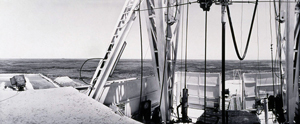 While oil and gas activities are vital to New Mexico and to those counties in which the industry operates, it also affects the lives of people nationwide. Together, oil and natural gas supply 65% of the energy we use every day. The U.S. oil industry alone employs nearly 1.5 million people. Oil fuels our planes, trains, trucks and other automobiles, and natural gas is used to heat and cool. Toys, TV’s, aspirin, and even toothpaste are products of petroleum.
While oil and gas activities are vital to New Mexico and to those counties in which the industry operates, it also affects the lives of people nationwide. Together, oil and natural gas supply 65% of the energy we use every day. The U.S. oil industry alone employs nearly 1.5 million people. Oil fuels our planes, trains, trucks and other automobiles, and natural gas is used to heat and cool. Toys, TV’s, aspirin, and even toothpaste are products of petroleum.
Acknowledgment
New Mexico Oil & Gas Association
http://www.nmoga.org
Uranium Mining
New Mexico’s energy and mineral wealth is one of the richest endowments of any state in the United States. New Mexico has the second largest identified uranium ore reserves of any state after Wyoming, but no uranium ore has been mined in New Mexico since 1998. Uranium mining in New Mexico is not what one would consider a success story. In fact, is it fraught with corporate disregard for the land and the indigenous people who worked the mines early on.
When Anglo-American miners appeared on the Colorado Plateau in the late nineteenth century, they extracted uranium, radium, and vanadium from small amounts of pitchblende and carnotite ore. Manual methods of mining, including the use of hand picks, sorting by hand, and transportation by burros or donkeys, limited the scope and impact of mining. During the early twentieth century, new mining methods included the use of diesel-powered equipment in underground mines and in transportation of ore by trucks to extraction mills. Thus began a dramatic increase in the impact of uranium mining on the areas resources.
The development of a boomtown economy from the 1940s through the 1960s on the Colorado Plateau coincided with federal government involvement in uranium mining providing financial incentives such as guaranteed ore prices, haulage and mine development allowances, production bonuses, fringe area and grade premium allowances. The 1950 discovery of uranium in the Grants, New Mexico area by a Navajo shepherd named Paddy Martinez, followed by the 1952 discovery of the MaVida Mine in Lisbon Valley prompted a well supported “uranium rush,” much of which occurred on reservation lands. The Navajo, Acoma, and Laguna tribes negotiated royalty agreements that required the use of local workers in mining operations, providing an economic boon after the devastating stock reductions during the 1930s.
Uranium mining operations were established on the Colorado Plateau in many locations, including some in Arizona (the Carrizo Mountains, the Lukachukai Mountains, Tuba City-Cameron area), in New Mexico (Churchrock-Crownpoint, the Ambrosia Lake and Jackpile districts on Mount Taylor), in Colorado (Naturita, Slick Rock, Durango, Grand Junction), and in Utah (Monument Valley, Moab, and Monticello).
Massive earth-moving equipment produced an exponential increase in the size of the mines and in the transportation network connecting mines to mills and markets. In the case of Anaconda’s New Mexico operations, a 65-mile railway link connected mine to mill. Depths of underground mines doubled or tripled, to 1000 feet, 1500 feet, and 2700 feet. The boom-time changed everything: size of the leases, depths of the mines, number of mill recovery facilities, and number of people involved in the industry, and the impact to the land and water resources.
Working conditions in the mines were abysmal by any standard. Miners, millers, truckers, and their families were exposed to radiation levels as much as 750 times the 1950 standards. By the 1950s, the first ghosts began to appear – ghosts of the victims of lung cancer, pulmonary fibrosis, pneumoconiosis, silicosis, tuberculosis, birth defects, and kidney damage. The Navajo called the ailments “red lungs” for the red they coughed up, or “uranium on the lungs” and “radiation around the heart.”
Leetso, the yellow monster, had released evil into Dine’tah. The industry went bust in the ‘80s, but the ghosts continue to congregate. A flood of eleven hundred tons of radioactive mill wastes and ninety million gallons of contaminated liquid poured down the Rio Puerco drainage at Church Rock, New Mexico, on July 16, 1979, thirty-four years to the day after Leetso’s birth.
The disaster at Church Rock was not an isolated event. The Nuclear Regulatory Commission acknowledges ten accidental releases of tailings (or uranium residue) solutions into major watercourses in the region between 1959 and 1977. Runoff of rainwater from tailings piles also contributes to the contamination of surface water. In 1984, a summer flash flood in Hack Canyon washed four tons of high-grade uranium ore into Kanab Creek and on to the Colorado River in Grand Canyon. In many communities, abandoned open pit uranium mines serve as stock tanks and swimming holes.
The mining and milling process greatly altered the land itself. The removal, transportation, and milling of vast quantities of rock resulted in the deposition of radioactive tailings piles at mine sites and at mill facilities. By 1978, the Government Accounting Office (GAO) recorded 140 million tons of on site tailings piles at twenty-two abandoned and sixteen operational mills. Continued production resulted in the addition of six to ten tons of tailings per year. One site, a 1.7 million-ton tailings pile, covers seventy-two acres in the center of Shiprock, New Mexico. Durango and Grand Junction, Colorado, and Monticello, Utah, are some of the other affected communities.
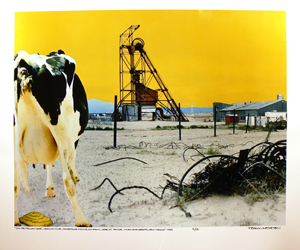 In 1992, the Navajo Nation president issued an executive order to reiterate the moratorium on uranium mining activity. Leetso, the yellow monster, is again raising his head. The world market for uranium is strong; the world’s reactors require 70,000 metric tons of U3O8; current world production is approximately 46,000 metric tons. An operation to mine uranium in situ by leaching with an alkaline solution has been proposed in the Crownpoint and Church Rock communities in New Mexico. Fears of groundwater contamination resulted in litigation by an association of community members to challenge the project’s operating license. The U.S. Nuclear Regulatory Commission requires that the mining company file an approved financial assurance plan to ensure cleanup of the mining site prior to commencing operation, which has effectively halted the project.
In 1992, the Navajo Nation president issued an executive order to reiterate the moratorium on uranium mining activity. Leetso, the yellow monster, is again raising his head. The world market for uranium is strong; the world’s reactors require 70,000 metric tons of U3O8; current world production is approximately 46,000 metric tons. An operation to mine uranium in situ by leaching with an alkaline solution has been proposed in the Crownpoint and Church Rock communities in New Mexico. Fears of groundwater contamination resulted in litigation by an association of community members to challenge the project’s operating license. The U.S. Nuclear Regulatory Commission requires that the mining company file an approved financial assurance plan to ensure cleanup of the mining site prior to commencing operation, which has effectively halted the project.
In 2003, Louisiana Energy Services (LES) proposed the National Enrichment Facility to be located near Eunice, New Mexico, in Lea County near the southeastern corner of the state. Uranium enrichment is a process by which natural uranium is separated into its component isotopes. Uranium-235, or enriched uranium, is used in fuel for nuclear reactors. The remaining uranium-238 is waste, and is also known as depleted uranium (DU).
The LES partnership is currently owned entirely by Urenco; previous partners dropped out following the issuance of the license to LES to construct and operate this facility. LES intends to use Urenco’s sixth generation gas centrifuge technology being used in Europe. Urenco has a capacity of about 20 percent of the world’s enrichment market.
Although the National Enrichment Facility has garnered extensive support, there remains serious concern regarding environmental, economic and political consequences.
Acknowledgments
Land Use History of North America: Colorado Plateau
MaryLynn Quartaroli
Northern Arizona University
http://cpluhna.nau.edu./Change/uranium.htm
United States Nuclear Regulatory Commission
Concerned Citizens for Nuclear Safety
Tourism
Overview
Travelers have been coming to the Southwest, and New Mexico in particular, for many thousands of years. The earliest nomadic hunter-gatherers were seeking their subsistence until the Mogollon culture, in approximately 100 BC, settled in, building permanent pit houses and learning to farm. The Ancestral Pueblo people came next, with both these groups developing into the early Pueblo Culture.
It is interesting to note that in the first millennium, there are indications that transcontinental travel existed, as native people engaged in complex exchange networks trading both raw materials and finished artifacts over vast areas of North America. Obsidian, copper, pearls and other objects found in Ohio Valley Hopewell burial mounds provide evidence of materials that came from as far away as the Rocky Mountains, the Atlantic Ocean, and the Gulf of Mexico.
As the Pueblo culture was putting down roots, the Athabascans—the Navajo and Apache people—moved in from the north. These hunter-gatherers ultimately developed a long and productive relationship with their Pueblo neighbors.
The next and biggest wave of travelers were the Spanish explorers in the 1500’s who were in search of wealth and glory, and certainly power. On their heels were the Spanish clergy seeking to convert “the heathens” to Christianity, and as the Spanish military presence grew, settlers moved into the Nuevo Mexico region. In 1598 Don Juan de Oñate built the first permanent settlement in the American west; Don Pedro de Peralta founded Santa Fe as the first capital in 1610. Many decades passed with fighting and bloodshed the norm, but the Spanish settlers were determined and remained. Travel and trade between Mexico and Nuevo Mexico continued to expand, with trade fairs from Taos to El Paso common by the 1790’s.
Mountain men began arriving in Taos by 1750, and with the Louisiana Purchase in 1803, Taos became a base of operation and a refuge for these predominantly French-Canadian and American trappers and traders. Mexico’s independence from Spain in 1821 dramatically changed the course of events in the New Mexico Territory. American traders were no longer outlawed, but were welcomed by the young Mexican government, hungry for the tariffs their merchandise would bring. The economy of New Mexico grew like wildfire.
From 1821 until the coming of the railroad in 1879, the Santa Fe Trail served as a vital commercial and military highway. The 900-mile trail connected Old Franklin, Missouri to Santa Fe and was the lifeline linking the New Mexico Territory to the Midwest and eastern United States. With Mexico’s independence from Spain, the Trail evolved into an international commercial highway used by Mexican and American traders.
The Trail provided a ready trade route for handmade indigenous goods from the New Mexico Territory to find their way into Victorian parlors and private collections back east. Traders, located at small posts in Hispanic villages, Navajo and Pueblo communities, accepted Native American 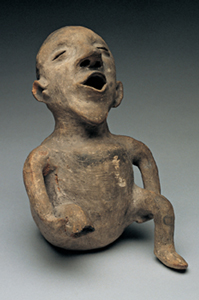 pottery and baskets, jewelry and weavings, and Spanish woodwork, weavings, and religious icons in exchange for the staples and manufactured goods they imported from the east. The traders then sold these objects to travelers and anthropologists as examples of a passing lifestyle, as the locals increased their dependence on manufactured products. Explaining this moment in the evolution of New Mexico’s economy, Joseph Traugott in How the West is One notes that, "the commodification of indigenous objects played a key role in New Mexico’s transition from a subsistence, agricultural economy to a money-based market economy." These trade items, representative of the indigenous culture of the Southwest, became an important factor in promoting tourism; they were not only useful as commodities for trade and art objects for collectors, but also as curios for travelers. Enterprising 19th century traders encouraged the indigenous people to make “tourist art”—smaller and cheaper mementos of their trip.
pottery and baskets, jewelry and weavings, and Spanish woodwork, weavings, and religious icons in exchange for the staples and manufactured goods they imported from the east. The traders then sold these objects to travelers and anthropologists as examples of a passing lifestyle, as the locals increased their dependence on manufactured products. Explaining this moment in the evolution of New Mexico’s economy, Joseph Traugott in How the West is One notes that, "the commodification of indigenous objects played a key role in New Mexico’s transition from a subsistence, agricultural economy to a money-based market economy." These trade items, representative of the indigenous culture of the Southwest, became an important factor in promoting tourism; they were not only useful as commodities for trade and art objects for collectors, but also as curios for travelers. Enterprising 19th century traders encouraged the indigenous people to make “tourist art”—smaller and cheaper mementos of their trip.
With the Louisiana Purchase, the ending of the Mexican-American War in 1848, and America's Civil War (1861–1865), the westward expansion of America would change this land forever. Empowered by the 19th century concepts of Manifest Destiny (the God-given directive for America to expand westward), and bearing the so-called “White Man’s Burden,” (the Christian moral obligation to convert and civilize Native peoples), European-Americans became the next tidal wave to journey to the Southwest.
The coming of the railroad to New Mexico in 1879 provided the easy access that was needed, opening full-scale trade and migration from the east and Midwest.
Beginnings of the Tourist Industry
The 1880’s saw extensive growth in the numbers of people traveling to the Southwest. New Mexico, its land and people, was a primary destination for:
- ranchers and homesteaders looking for cheap land to settle on,
- geological expeditions surveying the land,
- ethnologists studying and documenting Native American lifestyles,
- businessmen looking for opportunities to sell or manufacture their goods,
- adventurers and gold prospectors,
- artists and photographers seeking inspiration, and
- lawyers and politicians hoping to provide a legal and political system for the lawless territory.
With the arrival of the Atchison, Topeka, and Santa Fe Railroad in 1879, people could travel to New Mexico in relative ease, compared to the rigors of the Santa Fe Trail. As life back east prospered, a whole new population of travelers came west. These were the “tourists,” people who had the time and means to take tours for recreational or leisure purposes—a radical change in the concept of travel. With this newest influx, the conscious development of tourism as an industry took hold.
Tourists were attracted to New Mexico for its great natural beauty. As images of the region appeared in magazines and journals, easterners were stunned by the huge spaces, deserts, canyons, and mountains. These views provided a remarkable contrast to the gentler, refined landscape, and built-up towns and cities where they lived. When artist Frederick Dellenbaugh, who accompanied Major John Wesley Powell’s western geological expeditions, exhibited his landscape paintings at the 1904 St. Louis World's Fair, spectators could not believe such a place actually existed!
However, it was the exotic and romanticized images of Native American life that appeared in the pages of Harper’s and Scribner’s magazines that excited even greater interest—readers were fascinated with this vision of the Wild West and wanted to see it for themselves.
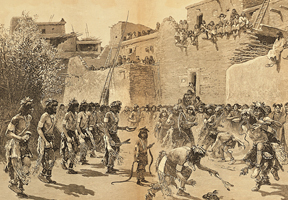 Artists flocked to New Mexico inspired by its vast natural beauty and the indigenous cultures that were so different from their own. Many of the early artists worked in a classical painting tradition that tended to romanticize native life. Not being ethnographers, they often created images mixing artifacts from their collections, thereby producing culturally inauthentic views of their subjects. These works were exhibited at galleries and expositions across the country, spreading a highly romantic, if not always accurate, vision of the Southwest.
Artists flocked to New Mexico inspired by its vast natural beauty and the indigenous cultures that were so different from their own. Many of the early artists worked in a classical painting tradition that tended to romanticize native life. Not being ethnographers, they often created images mixing artifacts from their collections, thereby producing culturally inauthentic views of their subjects. These works were exhibited at galleries and expositions across the country, spreading a highly romantic, if not always accurate, vision of the Southwest.
The Atchison, Topeka, and Santa Fe Railroad realized the collective power of these images for promoting travel, and was quick to appropriate the romance of the west as part of their advertising campaign. How could the Santa Fe Railroad make the trip itself appealing? For the gentrified tourist, traveling in comfort was a new concept. Enter Fred Harvey, whose impact on tourism in New Mexico is legendary.
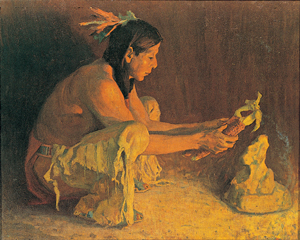 Fred Harvey was an innovative entrepreneur who understood the tourist’s needs, developing what became the first chain of restaurants across New Mexico and the west—The Harvey House— standardizing high quality food and service at railroad eating-houses. Later, at more prominent locations, these restaurants evolved into hotels, many of which survive today. By the late 1880s, there was a Fred Harvey dining facility located every 100 miles along the Santa Fe Line. Another innovation was his policy of hiring only female waitresses, the Harvey Girls, who were single, well-mannered, and educated "young women, 18 to 30 years of age, of good character, attractive and intelligent,” so his newspaper advertisement read.
Fred Harvey was an innovative entrepreneur who understood the tourist’s needs, developing what became the first chain of restaurants across New Mexico and the west—The Harvey House— standardizing high quality food and service at railroad eating-houses. Later, at more prominent locations, these restaurants evolved into hotels, many of which survive today. By the late 1880s, there was a Fred Harvey dining facility located every 100 miles along the Santa Fe Line. Another innovation was his policy of hiring only female waitresses, the Harvey Girls, who were single, well-mannered, and educated "young women, 18 to 30 years of age, of good character, attractive and intelligent,” so his newspaper advertisement read.
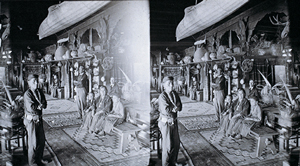 Harvey is known for pioneering the art of commercial cultural tourism. His "Indian Detours" were meant to provide an authentic Native American experience by having actors stage a certain lifestyle in the desert in order to sell tickets to unwitting tourists. He became a postcard publisher, both to promote business, and to serve as souvenirs. In 1902 at the Alvarado Hotel in Albuquerque, Harvey built a museum and gift shop to show and sell Native American art, and even earlier began to commission Indian jewelry to sell at his outlets. Harvey’s daring vision helped to create New Mexico as a major tourist destination. His multi-generational family business essentially invented the hospitality industry, radically changing the way Americans traveled and spent their leisure time forever.
Harvey is known for pioneering the art of commercial cultural tourism. His "Indian Detours" were meant to provide an authentic Native American experience by having actors stage a certain lifestyle in the desert in order to sell tickets to unwitting tourists. He became a postcard publisher, both to promote business, and to serve as souvenirs. In 1902 at the Alvarado Hotel in Albuquerque, Harvey built a museum and gift shop to show and sell Native American art, and even earlier began to commission Indian jewelry to sell at his outlets. Harvey’s daring vision helped to create New Mexico as a major tourist destination. His multi-generational family business essentially invented the hospitality industry, radically changing the way Americans traveled and spent their leisure time forever.
Acknowldegments
The Art of New Mexico: How the West is One
Joseph Traugott
Museum of New Mexico Press, Santa Fe, 2007
Appetite for America: How Visionary Businessman Fred Harvey Built a Railroad Hospitality Empire That Civilized the Wild West
Stephen Fried
Bantam, 2010
Tourism and the Arts
Tourism and the arts go hand in hand in New Mexico, from the early days when tourism became a conscious industry, through to our own times.
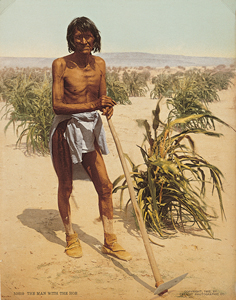 In the late 19th century the two main ideas motivating artists to visit and work here were the concept of New Mexico as a picturesque locale with an exotic and colorful population, and counter to this view, the goal of preserving and documenting authentic lifestyles of the Native American and Hispanic communities. Both of these visions resulted in paintings and photography shown back east in galleries and museums, magazines and newspapers, souvenir postcards, and incorporated into calendars and advertising materials.
In the late 19th century the two main ideas motivating artists to visit and work here were the concept of New Mexico as a picturesque locale with an exotic and colorful population, and counter to this view, the goal of preserving and documenting authentic lifestyles of the Native American and Hispanic communities. Both of these visions resulted in paintings and photography shown back east in galleries and museums, magazines and newspapers, souvenir postcards, and incorporated into calendars and advertising materials.
One early group of artists settled in Taos. Bert Geer Phillips had studied at the Julian Academy in Paris, where he met Ernest Blumenschein and Joseph Sharp. Their passionate interest in the landscape and people of the New Mexico pueblos inspired their fateful trip to the southwest in 1898. Outside of Taos, the wagon they were travelling in lost a wheel bringing them into the town where, inspired by the landscape, they decided to stop and paint. They became the only white artists operating in the region, displaying their work out of their studios, and becoming a major attraction for white tourists in Taos. The three artists helped found the Taos Society of Artists whose six original members, including E. Irving Couse, W. Herbert Dunton, and Oscar Berninghaus, tended to be European-trained illustrators and painters. By 1915, there were more than a hundred artists working in Taos, though only a handful were voted into the Taos society which finally disbanded in 1927, possibly due to decreased sales and publicity.
Classical European art, which had formed the foundation for most of the teaching that American artists experienced, had gone through a radical evolution. With the invention of the camera in the late 1800’s, adventurous artists in Europe felt liberated from the necessity to make representational art—the camera could do that! Instead, they began to experiment with artmaking itself as Impressionism, Expressionism, Fauvism and Cubism began to replace traditional picture making. In 1913, many American artists were treated to their first view of these new developments at the Armory for the Arts Exhibition in New York City where they saw the work of Cezanne and Matisse, Picasso and Duchamp, and a long list of other innovators. For some, it was considered a scandalous show, even an outrage. But for the history of American art, it was a watershed that introduced artists, collectors, art historians and the public accustomed to realistic art, to modern art. The show served as a catalyst for American artists, who became more independent and created their own "artistic language." New Mexico and its wide-open spaces offered an ideal place to explore, both in terms of subject matter and artistic style.
In the early years of the 20th century artists came to New Mexico in large numbers having been inspired by the early images, or having heard reports and seen the work of friends who had visited; some artists came for health issues finding the climate a respite for their tuberculosis. The coming of New Mexico Statehood in 1912 saw a rapid increase in the population.
Seventy miles south of Taos, a whole other arts community was rapidly developing. After the First World War, Santa Fe became what Joseph Traugott calls a “modernist destination,” as artists looking for fresh subject matter and a new approach in their painting came in droves. The modernist painters responded to the landscape and Native American and Hispanic life with more abstract, visually experimental paintings, which offered an opportunity for their own intellectual and emotional expression.
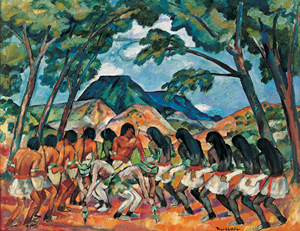 Another big draw for the modernists to Santa Fe was the opening in 1917 of the Museum of New Mexico Art Gallery (its name was changed to the Museum of Fine Arts in 1962). Edgar Hewett, an archeologist, educator, and administrator, was an instrumental figure in the development of the Museum and its first director. He understood the significance of the Museum and the arts for the economic development of the city and worked with local community leaders as well as state government to get the public and private funding that was needed to build a museum in a small town. Encouraged by Robert Henri, a well-known painter from New York City with a strong social conscience, Hewett developed the Museum’s Open-Door Policy, a non-exclusionary program which allowed any artist working in New Mexico to exhibit his or her work without the need for pre-approval by a jury. This radical democratic idea, closely allied to the progressive thinking of many younger Eastern artists, poets, and intellectuals, proved to be an enormous attraction.
Another big draw for the modernists to Santa Fe was the opening in 1917 of the Museum of New Mexico Art Gallery (its name was changed to the Museum of Fine Arts in 1962). Edgar Hewett, an archeologist, educator, and administrator, was an instrumental figure in the development of the Museum and its first director. He understood the significance of the Museum and the arts for the economic development of the city and worked with local community leaders as well as state government to get the public and private funding that was needed to build a museum in a small town. Encouraged by Robert Henri, a well-known painter from New York City with a strong social conscience, Hewett developed the Museum’s Open-Door Policy, a non-exclusionary program which allowed any artist working in New Mexico to exhibit his or her work without the need for pre-approval by a jury. This radical democratic idea, closely allied to the progressive thinking of many younger Eastern artists, poets, and intellectuals, proved to be an enormous attraction.
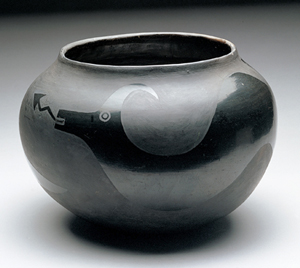 With a background in archaeology, Hewett also developed a program providing support for Pueblo artists like Maria Martinez, to work with historic clay and images, prompting a revival of pottery as a key ingredient in the economic development of Pueblo artists. The Museum’s open-door policy created a revolutionary model for exhibiting both indigenous Native American and Hispanic artists alongside the work of recognized New York painters and sculptors, making Santa Fe an ideal environment for the expansion of the arts for both economic development and as an attraction for tourists.
With a background in archaeology, Hewett also developed a program providing support for Pueblo artists like Maria Martinez, to work with historic clay and images, prompting a revival of pottery as a key ingredient in the economic development of Pueblo artists. The Museum’s open-door policy created a revolutionary model for exhibiting both indigenous Native American and Hispanic artists alongside the work of recognized New York painters and sculptors, making Santa Fe an ideal environment for the expansion of the arts for both economic development and as an attraction for tourists.
Many of the Modernist artists from New York joined forces in Santa Fe, just as the earlier artists did in Taos. Los Cinco Pintores consisted of Fremont Ellis, Jozeph Bakos, Walter Mruk, Will Shuster, and Willard Nash banding together in 1921 to experiment with modernist painting methods and leading colorful lifestyles. Another loose coalition called the New Mexico Painters formed in 1923 included Gustave Baumann, Ernest Blumenschein, and B.J.O. Norfeldt; their purpose, according to Time Magazine, November, 1923, was to hold annual exhibitions in New York, Chicago, and other art centers. For these artists, by the 1920’s the shift was from an ethnographic focus to painting itself. They were all interested in showing and selling their work.
As the arts community grew through the 1920’s, so did the conflicts around tourism—whether to maintain Santa Fe’s (and its indigenous and modernist) authenticity, or whether to cater to the tourist trade. Tourist revenues had become an essential component of the city’s income. In 1926 Route 66 wound its way through the state and car travel opened the floodgates—tourism expanded exponentially. A series of all-community events and festivals celebrating the city’s tri-cultural population provided an exciting destination for travelers interested in the arts and culture of the Southwest:
- The Santa Fe Fiesta, which had first taken place in 1712, was revived in 1919.
- The First Annual Exhibition of Indian Arts and Culture, took place in 1922, later evolving into the world-renowned Santa Fe Indian Market.
- In 1925, the Spanish Colonial Arts Society was founded and had its first Spanish Market in 1926.
- That same year artist Will Shuster moved his traditional burning of Old Man Gloom downtown behind City Hall, and the burning of Zozobra became an annual event.
.jpg) To provide a comfortable place for both in and out-of-state tourists to spend the night, La Fonda was remodeled in 1921. The Santa Fe Plaza became the hub of the city—the central place for locals and tourists to enjoy the city’s many cultural offerings.
To provide a comfortable place for both in and out-of-state tourists to spend the night, La Fonda was remodeled in 1921. The Santa Fe Plaza became the hub of the city—the central place for locals and tourists to enjoy the city’s many cultural offerings.
When the New York Stock Market Crash of 1929 put an abrupt stop to economic growth all across the country, the Southwest saw a sharp decline in tourism and the revenues the industry engendered.
Acknowldegement
The Art of New Mexico: How the West is One
Joseph Traugott
Museum of New Mexico Press, Santa Fe, 2007
Land of Enchantment
As Santa Fe and Taos were developing into arts destinations for travelers, other areas of New Mexico were being groomed for tourists interested in the natural wonders of the land. The year 1876 marked the grand centennial for the United States, and American nationalists seized upon the grand scenic vistas, particularly found in the American West, as a source of national pride. As the century neared its close, these "treasures" were increasingly included in national parks.
This national development had significant implications for tourism locally. The economic benefits to be derived from park status were not lost on early promoters. Parks brought visitors who would require a variety of services that translated into businesses and jobs. Following the Yellowstone Act, other park proposals proliferated as politicians sought a similar resource for their districts.
New Mexico’s own Stewart Udall, Secretary of the Interior under John F. Kennedy and Lyndon B. Johnson, played a monumental role in protecting not only the state’s, but the country’s natural resources. He aggressively promoted an expansion of federal public lands and assisted with the enactment of major environmental legislation. He oversaw the addition of four parks, six national monuments, eight seashores and lakeshores, nine recreation areas, 20 historic sites and 56 wildlife refuges to the National Park system. Udall’s work was central to the enactment of environmental laws such as the Clear Air, Water Quality and Clean Water Restoration Acts and Amendments, the Wilderness Act of 1964, the Endangered Species Preservation Act of 1966, the National Trail System Act of 1968, and Wild and Scenic Rivers Act of 1968.
Chaco Canyon
In the middle of the 19th century, several of Chaco's major ruins were rediscovered. The first archaeological investigation commenced in May 1896, when the Hyde Exploring Expedition started work on Pueblo Bonito. This expedition launched over a century of archaeological excavations and surveys in the canyon and outlying areas and led to the creation of Chaco Canyon National Monument in 1907 under the auspices of the 1906 Antiquities Act.
Beginning in 1937 the Civilian Conservation Corps, part of the New Deal Work Relief Program, funded an experimental Mobile Unit to work on ruins salvage and stabilization, continuing to 1970. The crew was mostly Navajo, including one female member. Many members of the current preservation crew are second-generation Chaco stonemasons related to the original team. By 1959, the National Park Service had constructed a park visitor center, staff housing, and campgrounds.
Chaco was listed with the National Register of Historic Places in 1966, and in 1980, the monument boundaries were expanded; the name was changed to Chaco Culture National Historical Park. The park received international attention when it was recognized as a World Heritage Cultural Park in 1987.
Acknowledgements
National Park Service
Chaco Culture, National Historic Park
http://www.nps.gov/archive/chcu/excavate.htm
Aztec Ruins
Aztec Ruins National Monument, bounded on the east by the Animas River, preserves an extensive community of multi-story structures, smaller residential buildings, roadways, ceremonial kivas, earthworks, and artifacts left by the 11th through 13th century ancestors of today’s Puebloans of the Southwest. The site was declared Aztec Ruin National Monument in 1923 and changed to Aztec Ruins in 1928. It was listed on the National Register of Historic Places in 1966, and in 1987 was added to the UNESCO list of World Heritage Sites, as part of the Chaco Culture National Historical Park.
Acknowledgements
National Park Service
Aztec Ruins National Monument
http://www.nps.gov/azru/historyculture/index.htm
http://www.nps.gov/azru/naturescience/index.htm
Bandelier National Monument
Bandelier's human history extends back for over 10,000 years when nomadic hunter-gatherers followed migrating wildlife across the mesas and canyons. By 1150 CE Ancestral Pueblo people began to build more permanent settlements. By 1550 the Ancestral Pueblo people, formerly called the Anasazi, had moved from their homes on the mesas to pueblos along the Rio Grande (Cochiti, San Felipe, San Ildefonso, Santa Clara, Santo Domingo).
In the mid-1700's Spanish settlers with Spanish land grants made their homes in Frijoles Canyon. In 1880 Jose Montoya of Cochiti Pueblo brought Adolph F. A. Bandelier, an influential nineteenth century historian and anthropologist to the region, which became one of Bandelier’s favorite places for archaeological research. He went on to undertake pioneering ethnographic and archaeological research in the American Southwest and the central Andes, laying the foundation for anthropological research in these areas.
The establishment of the Bandelier National Monument in 1916 was a direct result of conflicting pressures on the limited space of the Pajarito Plateau. Archaeologists, homesteaders, stockmen, and the Santa Fe business community all had a stake in the region. Each group thought its use should take precedence and none retreated from its position. The intervention of Federal agencies only complicated an already volatile situation, and the eventual establishment of the monument was a compromise that was a prelude to further conflict. In 1916 legislation to create Bandelier National Monument was signed by President Woodrow Wilson. Between 1934 and 1941 workers from the Civilian Conservation Corps (CCC) worked from a camp constructed in Frijoles Canyon. Among their accomplishments is the road into Frijoles Canyon, the current visitor center, a new lodge, and miles of trails. For several years during World War II the park was closed to the public and the Bandelier lodge was used to house Manhattan Project scientists and military personnel.
Today the National Park Service co-operates with surrounding pueblos, other federal agencies and state agencies to manage the park, which receives 300,000 visitors annually.
Acknowledgement
National Park Service
Bandelier National Monument
http://www.nps.gov/band/historyculture/index.htm
Gila Cliff Dwellings
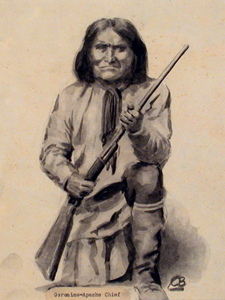 The Mogollon once flourished in the Gila region leaving their imprint when they moved on, around 1300. By the time the first Spanish set foot in southwest New Mexico, the Mogollons and Mimbrenos had both disappeared, and Apaches, mostly Chiricahua, inhabited the area. Led by famous chiefs such as Cochise and Geronimo, the Apaches retreated to a remote stronghold, into the rugged forests and mountains of the wilderness. Because of their fierce protectiveness, the area remained undeveloped into the 1870s when the Apaches were squeezed out by Mexican and white settlers, ranchers, miners and prospectors.
The Mogollon once flourished in the Gila region leaving their imprint when they moved on, around 1300. By the time the first Spanish set foot in southwest New Mexico, the Mogollons and Mimbrenos had both disappeared, and Apaches, mostly Chiricahua, inhabited the area. Led by famous chiefs such as Cochise and Geronimo, the Apaches retreated to a remote stronghold, into the rugged forests and mountains of the wilderness. Because of their fierce protectiveness, the area remained undeveloped into the 1870s when the Apaches were squeezed out by Mexican and white settlers, ranchers, miners and prospectors.
In 1907 President Roosevelt, by executive proclamation, set aside a quarter section of land containing the "Gila Hot Springs Cliff-Houses" as Gila Cliff-Dwellings National Monument, specifically prohibiting settlement on the reservation and damage or appropriation of any of its features.
Aldo Leopold, a former Forest Service employee who devoted most of his adult life to preserving the nation's wild places, lobbied to have the Wilderness preserved by an administrative process of excluding roads and denying use permits. Through his efforts, this area became recognized in 1924 as the first wilderness area in the National Forest System. In 1964 President Lyndon B. Johnson enacted The Wilderness Act of 1964 designating certain Forest Service primitive areas as wilderness where humans are considered visitors, not residents of these areas, and machines are not allowed. Gila became the first congressionally designated wilderness area in the Wilderness Preservation system.
Acknowledgements
National Park Service
Gila Cliff Dwellings
http://www.nps.gov/archive/gicl/adhi/adhi.htm
Desert USA
http://www.desertusa.com/gila/gila.html
White Sands
A determined group of local promoters dreamed of attracting some kind of development to the Alamogordo area in order to capitalize on the dunes. Many proposals had been submitted regarding commercial development of the gypsum found in the dunes, but none had come to fruition. Seizing on the park idea, Tom Charles, one of the leaders suggested, "Gypsum may be divided into two classes - Commercial and Inspirational. The former everybody has, but as for recreational gypsum, we have it all. No place else in the world do you find these alabaster dunes with the beauty and splendor of the Great White Sands".
 Charles' enthusiasm for the project was contagious and his perceptions about the value of the dunes also proved accurate. Interest in some sort of national recognition for the resource grew throughout the latter part of the 1920s. Studies were conducted by the National Park Service who determined that while the dunes might not meet the criteria for National Park status, which required a variety of resource values, the setting was ideal for preservation as a national monument. With the full backing of the New Mexico congressional delegation, as well as the support of communities from El Paso to Roswell, success was achieved.
Charles' enthusiasm for the project was contagious and his perceptions about the value of the dunes also proved accurate. Interest in some sort of national recognition for the resource grew throughout the latter part of the 1920s. Studies were conducted by the National Park Service who determined that while the dunes might not meet the criteria for National Park status, which required a variety of resource values, the setting was ideal for preservation as a national monument. With the full backing of the New Mexico congressional delegation, as well as the support of communities from El Paso to Roswell, success was achieved.
Formal recognition for the uniqueness of the white sands of southern New Mexico came in 1933, when President Herbert Hoover, acting under the authority of the Antiquities Act of 1906, proclaimed and established a White Sands National Monument.
In some ways the timing was fortuitous, for the establishment of the monument coincided with the dark days of the Depression and the economic recovery programs of the Roosevelt administration. WPA funds were used to improve many park areas and White Sands benefited by achieving a full measure of development within just a few years of opening. Construction projects included the visitor center/administrative building, maintenance facilities, public restrooms, and park residences. All of these buildings are still in service.
The park is currently examining its role as a laboratory for desert research and the potential for new programs in desert ecology. Its full moon evening guided walks are famous around the world. The park will also be looking for new ways to provide for visitor interaction with the desert’s resources.
Acknowledgement
National Park Service
White Sands National Monument
http://www.nps.gov/whsa/index.htm
Carlsbad Caverns
The park’s cultural resources represent a long and varied continuum of human use starting in prehistoric times, and illustrating many adaptations to the Chihuahuan Desert environment. Human activities, including prehistoric and historic American Indian occupations, European exploration and settlement, industrial exploitation, commercial and cavern accessibility development, and tourism have each left reminders of their presence, and each has contributed to the rich and diverse history of the area.
Carlsbad Cave National Monument was established in 1923 when the first photographs also appeared in the New York Times, stimulating interest in the cavern. Important events enhancing the rise of tourism were:
- From 1923 to 1927 the first trails, stairs and lights were installed, including a staircase from the natural entrance to Bat Cave.
- 1927. Cavern Supply Company was established as the park concessioner with an entry fee of $2.00 per person.
- 1928. Amelia Earhart visited the caverns.
- 1930. Congress designated the site as Carlsbad Caverns National Park.
- 1931. A 750' elevator shaft was drilled and blasted from both ends—the surface and the cavern, and the elevator was installed, going into operation in January 1932. (Two larger elevators and another shaft were added in the middle 1950s.)1937. The park received its 1 millionth visitor.
- 1938-1942. A Civilian Conservation Corps (CCC) camp was established at Rattlesnake Springs to continue construction.1959. Construction of the current visitor center was completed; old stone buildings near the cave entrance were removed and tour operations transferred to the visitor center.
- 1967. Self-guided trips through the Big Room were begun, with Rangers stationed at points throughout the Big Room interpreting their section as visitors pass by.
- 1986. Lechuguilla Cave is discovered to go further than expected. Over the coming years, it was taken to over 110 miles of explored passageway.
- 1995. Carlsbad Caverns National Park was declared a World Heritage Site.
- 2005. A total of 39,000,000 tourists have visited the Monument.
Today, Carlsbad Cave National Monument receives more annual visitors than any other cultural resource in the state.
Acknowledgement
National Park Service
Carlsbad Caverns National Park
http://www.nps.gov/cave/historyculture/upload/history_site_bulletin.pdf
The Bosque del Apache National Wildlife Refuge
The Bosque del Apache National Wildlife Refuge was established under Franklin Roosevelt’s administration in 1939 "as a refuge and breeding grounds for migratory birds and other wildlife." The U. S. Fish and Wildlife Service, with the support of farmers and the Friends of the Bosque del Apache, have effectively re-established a wetlands environment, following the ecological wreckage caused by forest destruction, overgrazing, excessive hunting, river diversion and alien plant invasion. The Bosque del Apache has become an important environmental success story attracting thousands of birders and other eco-tourists each fall to watch the return of the Sandhill Cranes, Snow Geese, and other species wintering there.
Acknowledgements
US Fish and Wildlife Service
Bosque del Apache National Wildlife Refuge
http://www.fws.gov/refuges/profiles/index.cfm?id=22520
Desert USA
Jay Sharp
http://www.desertusa.com/mag00/nov/stories/bosque.html
New Mexico’s Cities: Becoming Tourist Destinations
The arrival of the Model T Ford in1908 changed the face of America forever. As automobiles became accessible Americans began to travel further, and as travel increased, the public called for a standardized National Highway System. By 1926 a bill was signed in Washington D. C. and Route 66 became a reality. The 2,400-mile “Mother Road” connected small towns across the Midwest and West with the big cities of Los Angeles and Chicago. With road improvements and the advent of Interstate 40 and Interstate 25 later on, the ease of travel inaugurated a dramatic increase in tourism, with both small and large cities in New Mexico developing their unique tourist attractions.
Clovis
The city of Clovis, located in the Llano Estacado and largely an agricultural and ranching community, is also an important destination for tourists with two different interests.
Blackwater Draw was first recognized in 1929 as one of the most well-known and significant sites in North American archaeology. Early investigations at Blackwater Draw recovered evidence of human occupation in association with Late Pleistocene fauna, including Columbian mammoth, camel, horse, bison, sabertooth cat and dire wolf. Since its discovery, the site has been a focal point for scientific investigations by academic institutions and organizations from across the nation. The Blackwater Draw Museum first opened to the public in 1969 primarily to display artifacts describing and interpreting life at the site from Clovis times (over 13,000 years ago) through the recent historic period. Due to its tremendous long-term potential for additional research and to public interest, the site was incorporated into the National Register of Historic Places in 1982. More recently, it was declared a National Historic Landmark.
On a totally different note, Clovis describes itself at “the city built on Rock 'n' Roll.” Recently dubbed as New Mexico's 'best kept secret,' the Norman Petty 7th Street Studio is responsible for the "Clovis Sound," made popular by such greats as Buddy Holly and Roy Orbison who recorded at the studio. The original equipment is still in the studio. In 2007, the State of New Mexico recognized the studio with a NM Scenic Historic Marker, which is the first completed roadside marker commemorating Rock 'n' Roll culture that followed World War II. The Norman & Vi Petty Rock & Roll Museum honors Norman and Vi Petty and the artists who recorded at the 7th Street studio. A jukebox plays songs from the 50s and reminds visitors that Rock 'n' Roll is here to stay. The museum recreates a working recording studio from the 1950s and displays artifacts and memorabilia from the studios, including the original mixing board used by Norman Petty to record Buddy Holly and the Crickets. The annual Clovis Music Festival attracts hundreds of Rock 'n' Roll lovers.
Acknowledgements
Clovis Chamber of Commerce
http://www.clovisnm.org/
http://www.newmexicosouth.com/clovis/
Eastern New Mexico University
Blackwater Draw Museum
http://www.enmu.edu/services/museums/blackwater-draw/index.shtml
Las Cruces
Millions of years before the dinosaurs, Las Cruces teemed with reptiles and amphibians, whose stories are told in the endless scattering of fossils in nearby mountains and deserts. According to geologists, southern New Mexico was covered by a great inland sea 600 million years ago. When the sea retreated, many fossils were left behind.
The area where Las Cruces rose was first inhabited by the Mogollon People and later, the Apache. It was colonized by the Spanish beginning in 1598 when Juan de Oñate claimed all territory north of the Rio Grande for New Spain and later became the first governor of the Spanish territory of New Mexico. The area remained under New Spain control until 1821 when the First Mexican empire claimed ownership. The Republic of Texas also claimed the area during this time until the end of the Mexican American War in 1846-48. The Treaty of Guadalupe Hidalgo in 1848 established the United States as owner of this territory and Las Cruces was founded in 1849 when the United States Army laid out the town plans. The first train reached Las Cruces in 1881, but not being a terminus or a crossroads, the population only grew to 2,300 in the 1880s. Las Cruces was incorporated as a town in 1907.
Las Cruces has become the economic and geographic center of the fertile Mesilla Valley, the agricultural region on the flood plain of the Rio Grande extending from Hatch, NM, to the west side of El Paso, TX. The growth of Las Cruces has been attributed to the university, government jobs and recently retirees. New Mexico State University was founded in 1888, New Mexico's only land-grant institution. The establishment of White Sands Missile Range in 1944 and White Sands Test Facility in 1963 has supported the city’s growth and employment because Las Cruces is the nearest city to each.
Acknowledgement
Las Cruces CVB
http://www.lascrucescvb.org/html/las_cruces__new_mexico_history.html
Las Vegas
Las Vegas can claim some interesting characters as part of its draw to tourists as a true town of the Old West. Doc Holliday had a dentist’s office in town. Billy the Kid hung out there. Teddy Roosevelt visited and recruited many of his Rough Riders from the local population for the Spanish-American War.
The twenty-nine Spanish settlers, who founded the city in 1835, received the Las Vegas land grant from the Mexican government, laying out their fledgling town in the traditional Spanish manner, with a large central plaza anchoring the surrounding community. Las Vegas was New Mexico's first territorial capital—for one day. As the first New Mexican settlement encountered by supply trains on their journey on the Santa Fe Trail traveling from the United States, jobs and commerce increased as the town grew to over 1,000 people by 1860. During the next 20 years, its population quadrupled as it established itself as a major trade center, with businesses as well as residences lining the plaza. The arrival of the railroad in 1879 solidified the city’s position as a mercantile center. At its peak, Las Vegas’ trade area included all of eastern New Mexico and western Texas. A long period of economic decline followed the 1930’s Depression.
The Montezuma Hotel, later known as Montezuma Castle, was built in 1882 as a hot springs resort by the Fred Harvey Company and the Atchison, Topeka & Santa Fe Railroad, becoming the first building in New Mexico with electric lights. The resort hotel, close to the Montezuma Hot Springs, was a popular destination for travelers making the crossing from east to west and back. The Castle closed in 1903 and deteriorated; in 1981 the Armand Hammer Foundation bought the property locating the American campus of the United World College there. Tours are still being given.
The city’s long dormancy was a boon to historic preservation, since it stopped development and permitted an architectural feast for the many people who visit Las Vegas today. There are over 900 structures in Las Vegas that are listed on the National Register of Historic Places.
Northeast of Las Vegas is Fort Union National Monument. Established in 1851 to provide escort and protection for travelers on the west end of Santa Fe Trail, Fort Union grew to be the largest fort in the American Southwest, functioning as a military garrison, territorial arsenal, and military supply depot for the region.
Acknowledgements
Southwest Aviator
http://www.swaviator.com/html/issueMA04/lasvegasnm.html#Anchor-927
New York Times
http://www.nytimes.com/2007/11/16/travel/escapes/16american.html
Raton
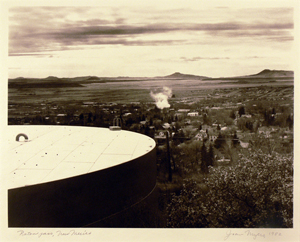 Raton Pass had been used by Spanish explorers and Indians for centuries to cut through the rugged Rocky Mountains, but the trail was too rough for wagons on the Santa Fe Trail. Raton was founded at the site of Willow Springs, a stop on the Santa Fe Trail. The original 320 acres for the Raton town site were purchased from the Maxwell Land Grant in 1880. In 1879, the Atchison, Topeka and Santa Fe Railroad bought a local toll road and established a busy rail line. Raton quickly developed as a railroad, mining and ranching center for the northeast part of the New Mexico territory, as well as the county seat and principal trading center of the area. In the early 1900’s, a visitor could have stayed at Raton’s Gate City Motel for $1.25 a night.
Raton Pass had been used by Spanish explorers and Indians for centuries to cut through the rugged Rocky Mountains, but the trail was too rough for wagons on the Santa Fe Trail. Raton was founded at the site of Willow Springs, a stop on the Santa Fe Trail. The original 320 acres for the Raton town site were purchased from the Maxwell Land Grant in 1880. In 1879, the Atchison, Topeka and Santa Fe Railroad bought a local toll road and established a busy rail line. Raton quickly developed as a railroad, mining and ranching center for the northeast part of the New Mexico territory, as well as the county seat and principal trading center of the area. In the early 1900’s, a visitor could have stayed at Raton’s Gate City Motel for $1.25 a night.
Dr. James Jackson Shuler served as mayor of Raton from 1899-1902 and 1910-1919, undertaking a number of impressive projects, including development of a Raton city park, electric and water filtration plant, Raton Water Works, Raton Public Library, and the construction of the municipal auditorium, the Shuler Theater, whose first production was a national touring company show of The Red Rose, a Victorian musical comedy that opened April 27, 1915.
Acknowledgement
City of Raton
http://www.ratonnm.gov/
Roswell
Blackdom was a small self-sufficient African-American community eighteen miles south of Roswell. Established in the early 1900s, it was an epicenter of social life during its heyday before succumbing to ghost town status in 1929. Blackdom was known far and wide for its famous mouth-watering pies and its Fourth of July and Juneteenth celebrations. At one point, it was even hailed for being the only community in the state with a college-educated teacher. October 26, 2002, was proclaimed Blackdom Day by the governor of New Mexico, and a historical marker was erected at a rest stop on Highway 285, between Roswell and Artesia to commemorate the community.
The 24,536-acre Bitter Lake National Wildlife Refuge was established in 1937 to provide habitat for thousands of migrating sand hill cranes and waterfowl. It is one of more than 500 refuges throughout the United States managed by the Fish and Wildlife Service. The National Wildlife Refuge System is the only national system of lands dedicated to conserving our wildlife heritage for people today and for generations yet to come, providing habitat for some of the most rare creatures in New Mexico.
The Roswell Museum and Art Center opened in 1937, deriving its initial support from the Works Progress Administration (WPA) as part of a Depression era project to promote public art centers nationwide. It was founded through an agreement with the City of Roswell, the WPA and Federal Art Project, the Chaves County Archaeological and Historical Society, and the Roswell Friends of Art. In its proposed plan, the WPA established that “the root of the community art center idea is participation by the entire community in all forms of art experience…” The stated purpose of the Museum was “to serve the art needs of Roswell [through] continuously changing exhibitions in the fine and practical arts, lectures and gallery talks [music programs and an art school where classes were offered free to the public]. The Museum has expanded, proving itself a popular stopping point for tourists visiting Chaves County.
Roswell's more recent history includes a mysterious crash of a supposed UFO that occurred north of the city in 1947. Responsible local citizens who witnessed the crash remained quiet about the doings until they retired. When their story surfaced, the city received world attention. Local business people encouraged the idea of a home for information on the Roswell Incident and other UFO phenomena; in 1992 the Roswell UFO Museum was opened to the public. The result has been thousands of people visiting annually and a new multi-million dollar tourism industry for the city.
Acknowledgements
New Mexico Tourism Department
http://www.newmexico.org/learn/wildlife/bitterlake.php
International UFO Museum and Research Center
http://www.roswellufomuseum.com
Roswell Museum and Art Center
http://roswellmuseum.org
Santa Fe
Santa Fe draws more than one million visitors annually.
The Native Americans that inhabited New Mexico long before Spanish contact continue to enrich the state today. There are nineteen pueblos located around the state; the Eight Northern Indian Pueblos surrounding Santa Fe offer an invitation to experience the timeless cultures, traditions, arts and beliefs of the Puebloans at Feast Days and Dances year-round.
Santa Fe is recognized as one of the most intriguing urban environments in the nation, due largely to the city's preservation of historic buildings and a modern zoning code, passed in 1958, that mandates the city's distinctive Spanish-Pueblo style of architecture based on the adobe (mud and straw) and wood construction of the past.
Santa Fe has also been the region's seat of culture and civilization (see the earlier section on “Tourism and the Arts” for an extensive discussion on its role as an art center). In fact, Santa Fe is considered one of the most distinctive arts destinations in the country; in 2005, Santa Fe became the first U.S. city to be chosen by UNESCO as a Creative City, one of only nine cities in the world to hold this designation.
Santa Fe's history as a capital city dates to 1610, when conquistador Don Pedro de Peralta established it as the capital for the Spanish "Kingdom of New Mexico." The Palace of the Governors, built in 1610, served as Spain's seat of government; it is the oldest public building in the country and now houses the state's history museum. Today's New Mexico State Capitol, known as the Roundhouse, is the only round capitol building in the country. It combines elements of New Mexico Territorial style, Pueblo adobe architecture and Greek Revival adaptations.
Other aspects of “The City Different,” that have attracted visitors both past and present:
- In the early 20th century many people were drawn to Santa Fe's dry climate as a cure for tuberculosis. These “lungers” were artists, politicians and scientists who came to the region seeking a healthier lifestyle. Spas and healing centers abound; the city’s many healing centers offer old and new modalities for attaining good health.
- In 1956 John Crosby built the Santa Fe Opera, which has developed into one of America's premier summer opera festivals, drawing 77,000 people to its open-air theater where the view is almost as exciting as the music.
- The city is surrounded by thousands of acres of pristine wilderness in the Sangre de Cristo Mountains and is an ideal location for hikers, skiers, snowshoers, mountain bikers, river rafters, and horseback riders.
Acknowledgements
Santa Fe Convention and Tourist Bureau
http://santafe.org/
http://santafe.org/Visiting_Santa_Fe/About_Santa_Fe/index.html
Taos
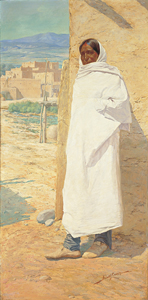 The city of Taos is located close to the Taos Pueblo, the village and tribe from which it takes its name. Taos Pueblo’s multi-storied adobe buildings have been continuously inhabited for over 1000 years, and is the only living Native American community designated both a World Heritage Site by UNESCO and a National Historic Landmark. In a landmark decision in 1970, the U.S. government returned sacred Blue Lake to Taos Pueblo.
The city of Taos is located close to the Taos Pueblo, the village and tribe from which it takes its name. Taos Pueblo’s multi-storied adobe buildings have been continuously inhabited for over 1000 years, and is the only living Native American community designated both a World Heritage Site by UNESCO and a National Historic Landmark. In a landmark decision in 1970, the U.S. government returned sacred Blue Lake to Taos Pueblo.
As the town of Taos grew, it played an active role in the tumultuous history of New Mexico. In the 1700’s it became a base of operation and a refuge for the predominantly French-Canadian and American trappers and traders; the Taos Trade Fair became even more popular as a result of their presence. As the town settled and civilized, it also slowly began to draw tourists. In 1898 the first American artists, Ernest Blumenschien and Bert Phillips arrived when their wagon wheel broke. They were inspired to stay, and later to establish an Artist Colony. Like Santa Fe, Taos became a seat of culture in the early 20th century (see the earlier section on “Tourism and the Arts” for an extensive discussion on its role as an art center) continuing to attract artists and art lovers to the present day.
Other attractions that have made Taos a major tourist destination in the 21st century are:
- The historic homes of Kit Carson (frontiersman), Mabel Dodge Luhan (arts patron), D.H. Lawrence (writer), and Padre Antonio José Martínez (early Parish priest, rancher, and community leader), Taos Plaza, one of the few places in the country where the American flag may be properly displayed day and night,
- San Francisco de Asis Church in Ranchos de Taos, an adobe church painted and photographed by almost every noted artist who has visited the town for its sculptural beauty.
- In 1955, Ernie Blake created Taos Ski Valley, and to this day skiers are attracted to Taos.
Acknowledgments
Taos County Historical Society
http://www.taos-history.org/time.html
Taos Chamber of Commerce
www.taoschamber.com/
Taos Pueblo
http://www.taospueblo.com/about.php
Tourism Today
Tourism is big business for the people, cities, and state of New Mexico. The travel industry:
- is the largest private sector employer,
- is the second largest private sector industry in the state,
- employs more than 110,000 workers,
- generates payroll in excess of $1 Billion, and
- travelers spend more than $5.7 Billion in New Mexico annually.
In addition to the traditional forms of tourism that travelers look for, both the cities and state have developed innovative offerings to attract travelers of all interests, incomes, and ages:
- Creative Tourism,
- Agritourism,
- Cultural and Heritage Tourism,
- Sustainable Tourism,
- Culinary Tourism,
- Eco-tourism,
- Astronomy Tourism,
- Gaming Tourism,
- Film Tourism.
Acknowledgments
New Mexico Tourism Department
http://www.newmexico.org/
Tourism Association of New Mexico
http://www.tanm.org/
Science and Techonology
The Defense Industry
Since 1945, New Mexico has been a leader in energy research and development with extensive experiments conducted at Los Alamos National Laboratory (LANL) and Sandia Laboratories in the nuclear, solar, and geothermal areas.
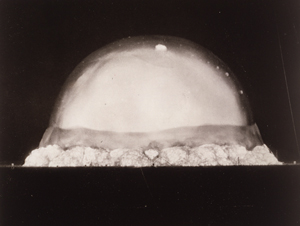 Los Alamos Laboratory, known as Project Y, was conceived during the early part of World War II. The United States wanted to build an atomic explosive to counter the threat posed by the German nuclear development program; the laboratory developed out of this vision. Since its creation, the primary responsibility of the laboratory has been to maintain the effectiveness of the nation’s nuclear deterrent. Though the world is rapidly changing, this essential responsibility remains the core mission of the laboratory.
Los Alamos Laboratory, known as Project Y, was conceived during the early part of World War II. The United States wanted to build an atomic explosive to counter the threat posed by the German nuclear development program; the laboratory developed out of this vision. Since its creation, the primary responsibility of the laboratory has been to maintain the effectiveness of the nation’s nuclear deterrent. Though the world is rapidly changing, this essential responsibility remains the core mission of the laboratory.
On its website, LANL is described as “one of the world’s leading research institutions…with laboratory personnel working on advanced technologies to meet the needs of the 21st century such as hydrogen fuel cell development, super computing, and applied environmental research.” LANL has done this repeatedly, starting with the WW II Manhattan Project, and continuing with the Human Genome Project, the Stockpile Stewardship Program, and the Comprehensive Nuclear Test-Ban Treaty.
The roots of Sandia National Laboratories also lie in WW II’s Manhattan Project, and its history reflects the changing national security needs of postwar America. In 1993, Martin Marietta took over Sandia’s management contract and two years later merged with Lockheed to become Lockheed Martin.
Sandia’s original emphasis on ordnance engineering – turning the nuclear physics packages created by Los Alamos and Lawrence Livermore National Laboratories into deployable weapons – expanded into new areas as national security requirements changed. In addition to ensuring the safety and reliability of the stockpile, Sandia applied the expertise it acquired in weapons work to a variety of related areas such as energy research, supercomputing, treaty verification, and nonproliferation.
Acknowledgments
Los Alamos National Laboratory
http://www.lanl.gov
Sandia Laboratory
http://www.sandia.gov
Bioscience
Central New Mexico’s history in Bioscience development is lengthy, from early research in respiratory disease in the late 1800s, to a modern command of computational biology. The local industry is greatly linked to the activities of local research institutions, as substantial Federal investment dominates the activity landscape. However, a number of innovative companies have developed their own intellectual property and cultivated niche markets in areas outside of Central New Mexico’s acknowledged institutional competencies.
Albuquerque boasts a seasoned bioscience cluster of more than 100 companies that produce everything from surgical supplies to non-invasive glucose testing devices for diabetics. Major commercial players here are Johnson & Johnson’s Ethicon Endosurgery, which manufactures surgical products, and Cardinal Health, which provides medication management systems to hospitals, and which acquired homegrown SP Pharmaceuticals in 2001. Many of the city’s bioscience companies are small and some are spin-offs from Sandia National Laboratories and the University of New Mexico.
New Mexico is home to a variety of additional bioscience organizations and companies:
- The National Center for Genome Resources in Santa Fe is a non-profit research institution dedicated to improving human health and nutrition through collaborative research at the intersection of Bioscience, computing and mathematics. Their vision is to pioneer the use of software and computation to improve treatment of diseases and nutrition.
- Founded in 1947, the Lovelace Respiratory Institute is a private biomedical research institute dedicated to the reduction of the nation’s substantial respiratory health burden. Lovelace respiratory research facility has extensive capabilities in a number of research areas: asthma, emphysema, lung cancer, inhalation toxicology, aerosol inhalation drug delivery, bronchitis, and allergies. The Institute brings a broad range of research capabilities and research alliances to bear on respiratory health issues of concern to government, industry, universities, health advocacy organizations, and the public. They are committed to the cure of respiratory diseases through research aimed at understanding their causes and biological mechanisms, eliminating exposures to causal agents, and developing improved treatments.
- University of New Mexico Health Sciences Center includes a medical school, colleges of nursing and pharmacy, four hospitals and the Cancer Research and Treatment Center. The Health Sciences Center can gather data and understand impacts with relative ease because it has a repository of data on entire populations of patients and access to high-performance parallel computing.
- The Santa Fe Institute is a private, not-for-profit, independent research and education center, founded in 1984, that is focused upon a multi-disciplinary approach to research in the physical, biological, computational, and social sciences. The Institute’s focus on understanding complex adaptive systems is critical to addressing key environmental, technological, biological, economic, and political challenges. Renowned scientists and researchers come to Santa Fe Institute from universities, government agencies, research institutes, and private industry to collaborate in attempts to uncover the mechanisms that underlie the deep simplicity present in our complex world.
- Biomedical Research Institute of New Mexico is a full service institution that exists to support Veterans Administration research programs to promote advances in medical diagnosis and treatment through research.
- Behavioral Health Research Center of the Southwest was established in 1997 to conduct research on substance abuse and other behavioral health issues. A major research focus is the impact of cultural factors on substance use and abuse.
Acknowledgments
The National Center for Genome Resources
www.ncgr.org
Lovelace Respiratory Institute
www.lrri.org
University of New Mexico Health Sciences Center
http://hsc.unm.edu/
Sandia National Laboratories
www.sandia.gov
The Santa Fe Institute
www.santafe.edu
Biomedical Research Institute of New Mexico
www.brinm.org
Behavioral Health Research Center of the Southwest
www.bhrcs.org
Green Economy
New Mexico is rapidly becoming a global leader in pure energy innovation. Abundant renewable energy resources, world-class clean technology research and manufacturing, attractive incentives, low business costs, and visionary state, federal and local government leadership are drawing international attention.
The state’s “Technology 21” is an eighteen-month collaborative plan that details ways in which the state can create high-wage tech jobs and business growth, according to the New Mexico Office of Science and Technology. The plan outlines five industries to target: aerospace, bioscience, energy/environment/water, information technology and nanotechnology, which are the five core areas of New Mexico’s particular strengths.
The New Mexico Wind Energy Center, the state’s most ambitious renewable energy project, officially went online in 2003. The center is the seventh-largest wind generation project in the United States. Located 170 miles southeast of Albuquerque and 20 miles northeast of Fort Sumner, the wind center is perfectly suited for eastern New Mexico’s windy landscape. Power production does not require water, produce emissions or general solid waste.
Acknowledgments
The New Mexico Wind Energy Center
www.pnm.com/systems/nmwec.htm
Area Development on Line
http://www.areadevelopment.com/stateResources/newMexico/
The Movies
Filmmakers come to New Mexico for the same reason painters and photographers come here: the light. It was the need for exotic locations that brought the inventors of cinematography (literally “writing with motion”) to the state when their technology was sufficiently developed to take it on the road. Because of New Mexico’s authentic old west locations and dramatic landscapes, the state has a rich history in Western cinema.
The Early Years
In the 1890s New Mexico Territory was still “the Wild West.” Eastern authors continued to depict it as the untamed backyard of the American republic where the law of the six-shooter reigned, and the dregs of society created constant turmoil among serious settlers trying to tame the land. Photography, born half a century earlier, promoted the landscape and cultures of the West even further as Matthew Brady’s ethnographic pictures of Native Americans were circulated widely.
Nonetheless, the American West was remote from the experience of most people. In 1898 Thomas A. Edison visited New Mexico territory, arriving by rail in Albuquerque. Indian Day School (1898), made by the Edison Company, shows a small group of Native American children and their teacher filing out of a Pueblo-style one-room schoolhouse, and then back in again. The film was only fifty seconds in length. The Edison primitive – a documentary, or “actuality,” as it would have been called at the time – was the first film shot in New Mexico Territory and one of the first ever in the American West.
By 1912, California had become “winter camp” for several fledgling film companies – not only independents, but also Edison’s company, Motion Picture Patents signatories, like Biograph. David Wark (D. W.) Griffith had been working at Biograph in New York, rising quickly through the ranks from writer of photoplays, to director, to master of the medium. With the Birth of a Nation (1915), he became known as the “father of the narrative film.” Griffith and the Biograph troupe had spent the winter months of 1911 – 1912 in Los Angeles churning out featurettes. At the end of May, they boarded the train to return to New York and stopped in Albuquerque to take in the local scene – and make a picture. As it turned out, they completed two films during their weeklong stay in New Mexico. One was a full-length dramatic love story, the other a short comedy.
Like the Edison Company filmmaker before him, D. W. Griffith went directly to the Isleta Pueblo to make a Romeo-and-Juliet tale about a Hopi maiden and her Pueblo boyfriend. A Pueblo Legend (1912), 20 minutes in length, is typical of Griffith’s work at that time. The star of the movie was Mary Pickford who in a few years became “America’s Sweetheart,” and the world’s highest-paid film artist. The other star of the film was the locale, with Griffith quoted as saying that “the Isleta Pueblo offered some of the finest scenic opportunities ever put into a picture.”
After Griffith came Romaine Fielding, creative director of the Lubin Company, a Motion Picture Patents signatory. Fielding filled a variety of roles for the film company, including lead actor, character actor, set designer, cinematographer, screenwriter and director. He was wildly eccentric and just as wildly imaginative. Fielding relocated his company to Las Vegas, N.M., where he made upward of a dozen featurettes over the next two years. In Las Vegas, he practically took over the town, at one point buying the landmark Plaza Hotel, renaming it the “Hotel Romaine,” and installing his production company there.
Selig Polyscope, another Patents Company, became resident of Las Vegas in 1914. Led by its own star/director, Tom Mix, it produced as many as 25 or 30 short Westerns over the next two years. Mix impressed the local population with his expansive personality and his insistence on performing all his own stunts, some of them quite dangerous.
The Talkies
At the end of the silent period, two remarkable film projects came to New Mexico: a watershed Western about Native Americans and one proposed feature-length documentary on the same subject.
Acoma was to have been an anthropological documentary-drama along the lines of the classic Nanook of the North (1922), directed by the gifted Robert Flaherty, who had practically invented the documentary form.
The actor Richard Dix starred in the other feature, Redskin (1928), shot on the Navajo Reservation in western New Mexico and in Gallup. A dramatic tale set against a backdrop of complex racial bigotries, Redskin also made use of Acoma locations. The film is notable on at least two levels: the compassionate treatment given Native Americans (they are the heroes of the story), and the ravishing color (partially in Technicolor), used as emotional underscoring, amber-tinted black and white man, full color for the sequences of Indian life.
It is interesting that the first period of New Mexico’s film history should begin and end with rapturous vistas of the land and romantic depictions of Native Americans against it. In between, movie stories ran the gamut from cowboys to labor unions, from menacing rattlesnakes to haggling tourists. The constant theme for filmmakers, though, has been the majestic landscape and its inhabitants.
Billy the Kid
The story of Billy the Kid has been an enduring subject for film work in New Mexico, evolving along with style and technology. Gallup also drew the accomplished director King Vidor when he made Billy the Kid in 1930 (starring Johnny Mack Brown). The advent of sound in motion pictures – “talkies” – brought challenges to location filming similar to those facing the Edison Company when they began to film outside the studio. In this case the decision of where to hide the microphone was as pressing as the camera setup. MGM’s gift to help Vidor capture the essence of the Southwest expanse was a new wide-screen process they called “Reallife.” Shooting Billy the Kid on 70mm film in an extreme rectangular image, twice as wide as high, provided tremendous sharpness. But theater owners were not about to invest in new projection equipment for 70mm; they were already complaining about the investment in the new sound film equipment. Vidor wisely shot simultaneously in 35mm and this was the film that was widely released.
Billy the Kid resurfaced in the cinema roughly three decades later in Arthur Penn’s The Left-Handed Gun (1958). This time the location was Santa Fe; the actor playing Billy was Paul Newman. Cinematography had developed to meet the needs of a new introspective style of acting, Method acting, which meant more extreme close-ups of faces and hands, and flexible camera angles. To underscore the psychological drama rather than highlight background details as in many action Westerns, the film was shot in black and white, and Penn used swirling camerawork to stylize the gunfights.
Another 30 years passed and yet another Billy was to appear, in the form of Emilio Estevez in Chris Cain’s Young Guns (1988). Again responding to the trends formed by audience demand, the cinematographic technology had evolved to the present-day sharpness of color, crisp image and clarity of sound that could be as mobile as the galloping horses and gun battles being filmed. This production emphasized detail in surroundings and turned the real-life village of Cerrillos into old Lincoln of the 1870’s. Shot in the wide-screen format Cinemascope, Young Guns brings to light the simple fact that in spite of the advances and refinements made in cinematography, motion picture cameras still function in essentially the same way as they did a century ago…telling a good story.
Economic Impact
In the last ten years, New Mexico has been particularly aggressive in courting Hollywood. The state has become one of the top filming destinations in the country by offering filmmakers a 25% refund of all in-state production costs and interest-free loans of up to $15 million. More than 150 film and television projects have taken advantage of the incentives since they were introduced in 2002. No small city in the state has seen more film action than Las Vegas, which has hosted such films as No Country for Old Men, North Country, The Longest Yard, and Wild Hogs.
Unlike scores of states seeking film shoots that pack up and leave when they are finished, New Mexico is zeroing in on the nuts and bolts of Hollywood. By luring the support companies that form the bedrock of the Los Angeles entertainment economy, New Mexico aims to lay the foundation for a top-tier movie and TV production business.
Sony Pictures Imageworks plans to move a major chunk of its visual effects business – and more than 100 jobs – from Culver City to Albuquerque Studios.
In nearby Rio Rancho, Lions Gate Entertainment is gearing up to build a $15-million production center on 20 acres provided by the city, and with the help of a pending $10-million loan from the state.
The New Mexico State Film Office and State Investment Council notes in the Executive Summary of its January 2009 Report on the Economic and Fiscal Impacts of the New Mexico Film Production Tax Credit:
New Mexico has provided tax incentives to film productions since the film production tax credit was adopted in 2002. The program has attracted more than 115 major film productions to New Mexico since its adoption in 2002, including 22 films that were assisted through the State Investment Council’s loan participation program. In 2007, 30 films were produced in New Mexico generating $253 million of spending benefiting the New Mexico economy and generating higher state and local tax collections.
The benefits of New Mexico’s film production tax credit program extend beyond the direct and indirect economic impacts of film production activities qualifying for tax credits. In addition to the film spending, New Mexico’s economy also benefits from capital investment to support the film industry’s growth in the state and additional film-related tourism.
- Film production activities in New Mexico created 2,220 direct jobs in 2007. This employment impact includes approximately 1,670 below the line employees earning $49,500 annually and 550 actors, directors, and producers working in New Mexico. These 2,220 direct jobs created 1,609 additional jobs in other industries, resulting in a total employment impact of 3,829 jobs.
- Film-related capital expenditures and projected film tourism spending attributable to 2007 productions generated an estimated 3,769 direct jobs and 1,612 indirect jobs, resulting in 5,380 total jobs attributable to capital expenditures and film tourism.
- Combining the 2,220 direct jobs from film productions with the 3,769 jobs from capital expenditures and film tourism results in 5,989 total direct jobs attributable to the film production tax credit. These direct jobs create a total of 3,221 indirect jobs, resulting in a total employment impact of nearly 9,210 jobs.
- The economic activity created by the film production tax credit program also results in higher state and local tax collections. State tax collections resulting from film production activities in 2007 totaled $22.6 million. Additional state tax impacts from capital expenditures in 2007 and film tourism during 2008-2011 are estimated to total $21.5 million in 2007 dollars, resulting in a total state tax impact of $44.1 million.
- Film production expenditures in 2007 qualified for $49.4 million of state film production tax credits to be paid in 2008. Expressed in 2007 dollars, these film credits total $47.1 million. Based on the 2007 value of present and future year tax receipts and the 2007 value of state film production tax credits, the program earns $0.94 in additional tax revenue for each $1.00 that is paid out in incentives. Local governments in New Mexico earn $0.56 for each dollar of state credits, resulting in combined state and local tax collections of $1.50 for each $1.00 of state credits.
Movie making is alive and well in New Mexico!
Acknowledgments
Stephen Siegfried
New Mexico Business Journal, March, 1998
Joseph Dispenza
New Mexico Film Museum
J. B. Smith
New Mexico Film Museum
Kate Linthicum
Los Angeles Times, July 20, 2009
Richard Verrier
Los Angeles Times, April 2, 2007
Economic and Fiscal Impacts of the New Mexico Film Production Tax Credit;
Prepared for the New Mexico State Film Office and State Investment Council
January, 2009
http://www.nmfilm.com/locals/downloads/nmfilmCreditImpactAnalysis.pdf
Astronomy and Space
New Mexico has played a major role in the understanding and exploration of space. From ancient Native American observatories at Chaco Canyon to modern day facilities such as the Very Large Array astronomical radio observatory, New Mexico’s clear skies and high altitudes have provided an ideal location to study the skies. Robert Goddard and Wernher von Braun’s experimental rocketry, NASA’s testing and space missions, and more recently Spaceport America, have all prospered in New Mexico’s open space and low population.
Chaco Canyon
Rich with the thousand-year-old artifacts and architecture of the ancient Pueblo culture, this canyon is also home to a number of sites that are thought to be ancient observatories. At these sites, some as simple as a few circles carved on a rock face, shafts of sunlight align with human-made markers that were probably used to chart and celebrate cosmological patterns, in particular, the seasonal shifts of the sun.
We say “probably” because there’s no way to know exactly what the inhabitants of Chaco Canyon had in mind when they crafted the various sites that today we invest with astronomical significance. Still, the great number of possible sites constitutes a preponderance of evidence that, while circumstantial, is hard to ignore.
 Pueblo Bonito is the largest and most fully excavated of the “great houses” at Chaco Canyon. Its D-shaped plan rose four to five stories high and enclosed almost seven hundred rooms and thirty-five kivas. Pueblo Bonito is bisected by a prominent wall that is precisely aligned with true north. As the sun traverses the sky each day, the shadow of this wall disappears at high noon.
Pueblo Bonito is the largest and most fully excavated of the “great houses” at Chaco Canyon. Its D-shaped plan rose four to five stories high and enclosed almost seven hundred rooms and thirty-five kivas. Pueblo Bonito is bisected by a prominent wall that is precisely aligned with true north. As the sun traverses the sky each day, the shadow of this wall disappears at high noon.
The great Kiva Casa Rinconada is a circular structure, half-sunk into the earth on a hill.
Kivas are ceremonial places in Pueblo culture, as well as symbols of the cosmos. Aligned with the cardinal directions, the line connecting the north and south doors to Casa Rinconada is within one-third degree of true north. A compelling but contested alignment exists within Casa Rinconada. At sunrise on the summer solstice, a beam of light from a northeastern opening in the kiva precisely illuminates a niche in the far wall. The niche in question is one of many, however it is only one of several that are uniquely placed.
Many of the structures at Chaco Canyon are aligned with the cardinal directions: north, south, east, and west. A prominent example is the Great North Road, an ancient Chacoan road extending thirty-five miles north of Chaco Canyon. Speculations abound about the purpose of the thirty-foot-wide roadway. Some argue that the road was more ceremonial than functional, a reflection of Puebloan beliefs about the origins of their existence. Aspects of the road point to its symbolic (as opposed to functional) value. In some areas the road splits into four parallel segments. Meanwhile, it travels doggedly north without regard to the landscape, even scaling vertical cliffs.
New Mexico’s Space Triangle
If southern New Mexico has one thing in abundance, it’s wide, open spaces. But the plains and mesas of the Chihuahua Desert also hide a kind of space that extends beyond the horizon, the kind that inspires visionary rocket scientists, secret government research, conspiracy theories, and religious cult leaders. Roswell, Alamogordo, and Las Cruces all have earned a place in space history as centers for both cutting-edge technology and outer-space speculators.
Roswell
Roswell’s connection with space began in 1930 when Robert Goddard moved to the city to conduct his liquid-fuel rocket experiments. By 1940 he had launched 56 rockets from a nearby ranch.
Goddard received patents for a liquid-fuel rocket and multi-stage, solid fuel rocket. He was to rocketry what the Wright brothers were to powered flight. NASA named the Goddard Space Flight Center in Maryland after the scientist who died in 1945, one month after the Manhattan Project detonated the first atomic bomb at the Trinity Site on the White Sands Missile Range, just 125 miles away.
Since the famous “Roswell UFO Incident,” the alleged recovery of extra-terrestrial debris, including alien corpses, from an object which crashed near Roswell in June or July 1947, this small farming town has been world headquarters for UFO believers and conspiracy theorists. About 260,000 curious visitors flock to the UFO Museum every year where the exhibits raise some unanswered questions that might indicate there was some kind of government cover up.
Alamogordo
Alamogordo, 100 miles west of Roswell, adds to the area’s space legacy with the White Sands Missile Range. The large expanse of uninhabited land, level terrain, and predominantly clear skies met the Army’s requirement for year-round operation of a guided missile testing program, which was established as White Sands Proving Ground in 1945. Renamed White Sands Missile Range in 1958, today it supports NASA, Industry and Department of Defense projects. Holloman Air Force Base, adjacent to the missile range, has played a key role in space-related research also. It is home to the 46th Test Group, which operates the Air Force’s 9.5-mile high-speed test track to test missile components, guidance systems, aircraft escape systems, and human responses to acceleration and deceleration. Much of the equipment used in the Apollo moon mission was tested at NASA’s White Sands Test Facility, and its adjacent Tracking and Data Relay Satellite System ground terminal links scientists on earth with vehicles in space.
Las Cruces
Las Cruces is the southern gateway for the Missile Range and NASA test facility. Long before a rocket blasts off with astronauts and payloads, NASA tests the launch systems at the missile range, so the road to outer space passes through Las Cruces. The town had been called “The Crossroads of History” since the 1854 Gadsden Purchase, which secured land from Mexico, was signed in Mesilla, now part of the city.
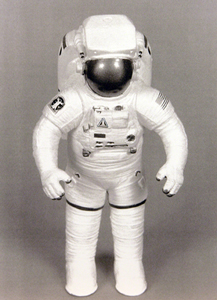 Spaceport America is located in a remote region of southern New Mexico.British billionaire Richard Branson’s vision is to have tourists paying around $200,000 to board “SpaceShip Two,” the six-seat reusable spacecraft developed by American engineer Burt Rutan. On March 22, 2010, VSS Enterprise, the world’s first commercial manned spaceship left Earth for the first time and performed a flawless maiden flight attached to the VMS Eve Mothership. The flight lasted just short of three hours and both vehicles climbed to an altitude of 45,000 feet.
Spaceport America is located in a remote region of southern New Mexico.British billionaire Richard Branson’s vision is to have tourists paying around $200,000 to board “SpaceShip Two,” the six-seat reusable spacecraft developed by American engineer Burt Rutan. On March 22, 2010, VSS Enterprise, the world’s first commercial manned spaceship left Earth for the first time and performed a flawless maiden flight attached to the VMS Eve Mothership. The flight lasted just short of three hours and both vehicles climbed to an altitude of 45,000 feet.
Apache Point Observatory
The Sloan Digital Sky Survey, undertaken at Apache Point Observatory in Sunspot, NM, is one of the most ambitious and influential surveys in the history of astronomy. Over the course of 10 years it carried out a survey of unprecedented depth over one quarter of the sky. Results from the telescope have benefitted almost every branch of astronomy, but of particular note was the discovery of many objects so distant that the light observed from them started its journey toward Earth when the Universe was only one tenth its present age.
Very Large Array (VLA)
The VLA is used primarily by astronomers from around the world. It is also occasionally used for atmospheric/weather studies, satellite tracking, and other miscellaneous science. The 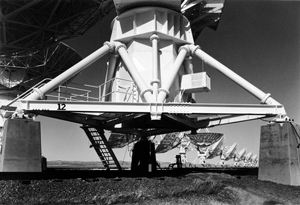 is an interferometer; this means that it operates by multiplying the data from each pair of telescopes together to form interference patterns. The structure of those interference patterns, and how they change with time as the earth rotates, reflect the structure of radio sources on the sky: they then can take these patterns and use a mathematical technique called the Fourier transform to make maps.
is an interferometer; this means that it operates by multiplying the data from each pair of telescopes together to form interference patterns. The structure of those interference patterns, and how they change with time as the earth rotates, reflect the structure of radio sources on the sky: they then can take these patterns and use a mathematical technique called the Fourier transform to make maps.
One of the world's premier astronomical radio observatories, the VLA consists of 27 radio antennas; each antenna is 25 meters (82 feet) in diameter. Its Y-shaped configuration is located on the Plains of San Agustin west of Socorro.
Earth’s Space Caves
El Malpais, which spreads for miles around the city of Grants, NM is saturated with caves, called lava tubes, built from a few million to tens of thousands of years ago when hot magma shot through other rock and left empty pathways behind, reminiscent of the path an earthworm leaves when traveling through dirt. These caves are important to planetary scientists because there’s strong evidence that they also exist on the moon and on Mars, and studying them here can tell us a lot about the environments on other worlds.
The Spirit rover on Mars discovered what appears to be a collapsed lava tube. Larry Crumpler, a member of NASA’s Mars Exploration Rover Team and the space sciences research curator at the New Mexico Museum of Natural History and Science, and other scientists plan to move the rover toward a volcanic area that could have other tubes and caves.
In the 1960’s, Apollo astronauts used to train in New Mexico because areas of the state mimic the dry, rocky setting on the moon and Mars. One day in the not so far future, astronauts could very well train here again and use the caves to learn how to build lava tube habitats on other planets.
Acknowledgments
- New Mexico Museum of Space History
www.nmspacemuseum.org
- New Mexico Museum of Natural History and Science
http://www.nmnaturalhistory.org/
- Chaco Canyon
http://www.exploratorium.edu/chaco/
- New Mexico Space Museum
www.nmspacemuseum.org
- Very Large Array
http://www.vla.nrao.edu/
- Roswell
www.roswellufomuseum.com
www.roswellmysteries.com
www.UFOfestivalRoswell.com
- Alamogordo
www.nmspacemuseum.org
http://www.nps.gov/whsa/
www.alamogordo.com/tourism.htm
- Las Cruces
http://www.spaceportAmerica.com
http://www.spaceportamerica.com/about-us/history.html
www.lascrucescvb.org
- Sunspot
http://www.apo.nmsu.edu/
http://www.sdss.org/
- "Earth’s Space Caves"
Article by Sue Vorenberg – published by Santa Fe New Mexican on Sunday, September 28, 2008
- Observatories located in New Mexico
www.astronomyclubs.com/5/190/33/0/club.aspx

